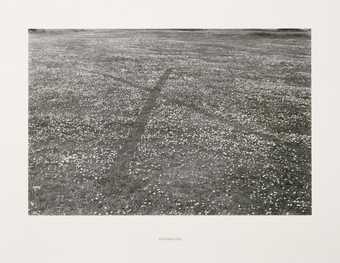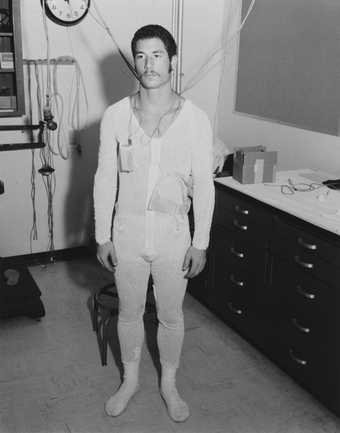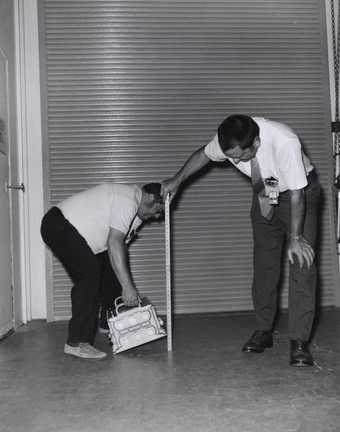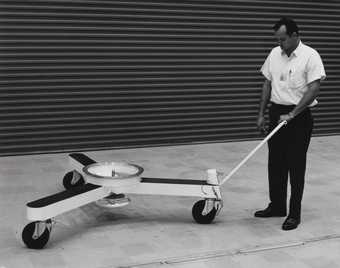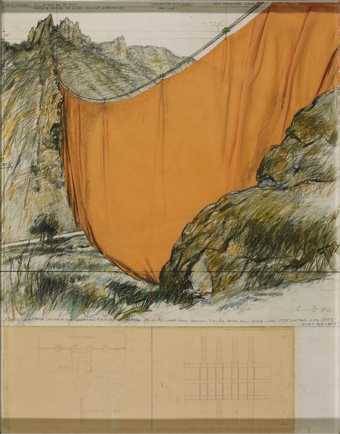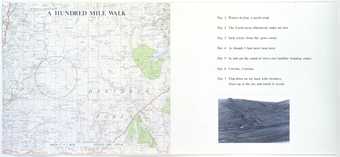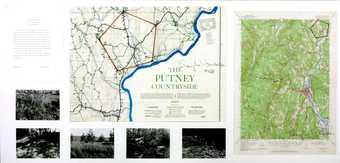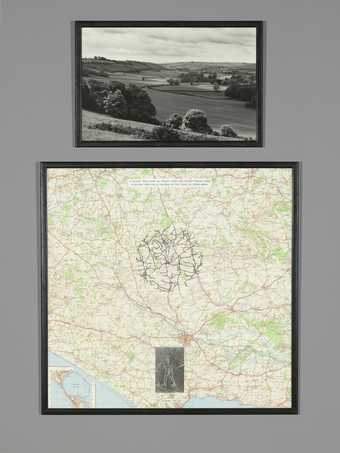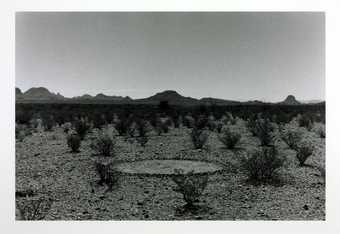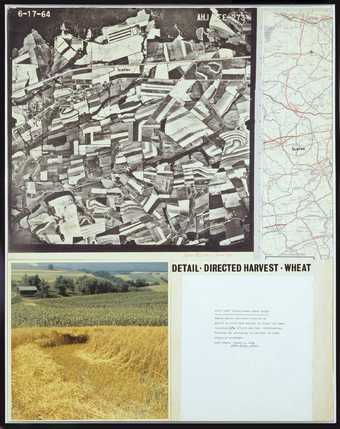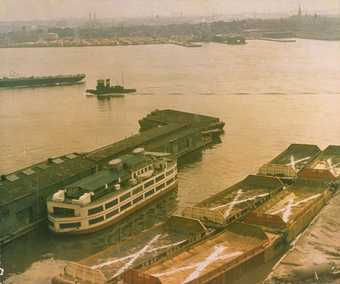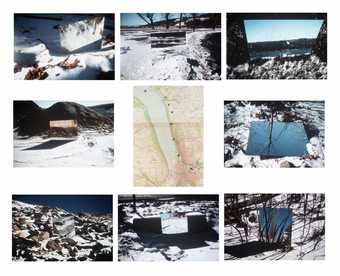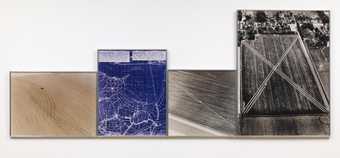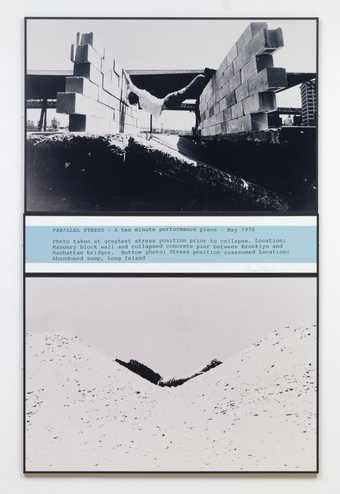
Not on display
- Artist
- Dennis Oppenheim 1938–2011
- Medium
- Photograph, map and typescript on board
- Dimensions
- Unconfirmed: 711 × 559 mm
- Collection
- Tate
- Acquisition
- Purchased 1973
- Reference
- T01773
Display caption
Oppenheim spread 1,000 pounds of salt into a 50 x 100 foot rectangle in a parking lot in New York. This work includes a map showing the location of the site, and a photograph of the salt in position. Oppenheim intended to place salt blocks of identical weight on the ocean bed off the Bahamas, and along the surface of the Salt Lake desert in Utah. In each context, the salt would undergo change, whether spreading out, disintegrating in water, or becoming incorporated into a solid salt surface. These later actions were never carried out.
Gallery label, February 2016
Does this text contain inaccurate information or language that you feel we should improve or change? We would like to hear from you.
Catalogue entry
Dennis Oppenheim born 1938
T01773 Salt Flat 1968
Inscribed 'Dennis Oppenheim 1968' b.r.
Photograph, map and typewritten text mounted on card, 28 x 22 (71.2 x 56)
Purchased from the Mayor Gallery (Grant-in-Aid) 1973
Prov: With Mayor Gallery, London (purchased from the artist through the Sonnabend Gallery, New York and Paris, 1973)
Exh: Dennis Oppenheim, Mayor Gallery, London, September-October 1973 (4)
Lit: David L. Shirey, 'Impossible Art - What it is' in Art in America, LVII, May-June 1969, pp.32, 34
This work is the documentation of a land activity that Oppenheim carried out in New York on 28 November 1968 when he spread 1000lbs of finely granulated baker's salt on a vacant asphalt parking lot in a rectangle 50ft by 100ft. It comprises a map of Manhattan on which the site is marked with a cross and a circle, a colour photograph of the salt in position, with the artist standing beside it, and an explanatory text. The text reads:
SALT FLAT 1968
Location: (part 1) 6th Avenue and 25th Street New York City
1000 pounds of bakers salt 50' x 100' on asphalt surface. Identical dimensions are to be transferred in 1' x 1' x 2' salt lick blocks to ocean floor off Bahama coast xx and dug to a 1' depth - Salt Lake Desert, Utah.
Another documentation of the same installation is reproduced in the catalogue of Oppenheim's exhibition at the Galerie Matthias Fels, Paris, in April-May 1972 (9, repr.). It also consists of a map, a colour photograph and a typewritten text, but has the map (a larger view of Manhattan and its surroundings) at the top and the colour photograph (the same photograph but trimmed and on a reduced scale) below, so that their relative sizes and positions are reversed. There was also a third document showing the stages of the transference of the salt to the pavement.
Oppenheim says that this work was the inspiration behind his and Peter Hutchinson's joint exhibition Two Ocean Projects at the Museum of Modern Art, New York, in October-November 1969. He was given a grant by the de Menil and List Foundations to carry out the remaining stages of the project and went to the Carribbean with Hutchinson, but by the time he got there he had other projects in mind and the two latter parts of the Salt Lake project were never executed. It would have been easy to plot out and excavate an area of salt 50 x 100ft to a depth of one foot from Salt Lake Desert, but there would have been a few difficulties over getting the blocks to the Bahamas, shipping costs and the cost of purchasing the blocks. The blocks would not disintegrate immediately if put into the sea, but they would have had to be tied together in some way in order to reconstruct the same dimensions.
The ideas behind the piece, which started it off, were those of three different elevations (flat plane, below sea, high point in the desert) and three material changes (granular salt spread sheet thin, absence of salt within a salt plain, salt blocks disintegrating in the ocean).
He thought of the area of salt in New York as if it was viewed from the top of the Empire State Building and as such it would appear to be the whitest thing in the city grid. It was thus also seen in a larger context than in its own relative state. However no photograph was taken of it from the Empire State Building, as it became dark before this was possible. The existing photographs were taken from the third floor of a building across the street. The salt took three or four days to disappear completely (being blown away by the wind).
It was one of his earliest pieces dealing with decomposed materials and, like his snow pieces, involved powdery material of an essentially impermanent kind. His concern with the state of the material used grew out of a need to oppose what could be called 'aesthetic control' and, from this point of view, material left in its original state had the advantage that it responded best to natural laws. His first work of this kind was 'Gallery Decomposition' of 1968 in which he used cement and gypsum, the prime materials of the interior of the Stedelijk Museum, Amsterdam. As he said, 'I de-architecturalized (removed the catalyst from) the interior'. In the 'Salt Flat' piece he was using the city as the framework for the vestige of a desert (implying the Salt Lake Desert). The Fort Kent snow pieces in Maine were done three weeks later. He considers that 'Salt Flat' is also related to his Stock Exchange piece made in 1969 in which the paper residue of the New York Stock Exchange floor was transferred to the roof of a building elsewhere. Both related to abstract points within a global structure and involved a close look at materials. 'Salt Flat' was in fact his fifth or sixth piece on the theme of the act of removal or transplant.
The figure was placed in the photograph because the photographer, Robert O'Connor, felt one was needed to give an idea of the scale. Oppenheim said he did not consider it particularly important who took the photographs of his work, but he tries to take them himself whenever possible.
The documentation was presented in what seemed to him the simplest, most basic way. The event took place and was recorded several months before the first version was made, as he did not send the film to be processed until his return from Maine after Christmas 1968. He could not remember for certain the order in which the Tate's work and the one exhibited at the Galerie Matthias Fels were done, but the third version, about the procedure of placing the salt and including four photographs of the salt being put in position, was definitely made later, probably in 1970, after he had decided not to carry out the two final parts of this project.
Published in:
Ronald Alley, Catalogue of the Tate Gallery's Collection of Modern Art other than Works by British Artists, Tate Gallery and Sotheby Parke-Bernet, London 1981, pp.576-8, reproduced p.576
Explore
- architecture(30,960)
-
- townscapes / man-made features(21,603)
-
- car park(67)
- formal qualities(12,454)
-
- photographic(4,673)
- food and drink(980)
-
- salt(5)
- map(110)
- actions: postures and motions(9,111)
-
- standing(3,106)
- man(10,453)
- individuals: male(1,841)
- USA, New York(317)
- inscriptions(6,664)
-
- artist’s notes(1,553)
- printed text(1,138)
- arts and entertainment(7,210)
-
- artist, sculptor(1,668)
You might like
-
Richard Long CBE A Line Made by Walking
1967 -
Richard Long CBE England 1968
1968 -
Larry Sultan, Mike Mandel Untitled
1977, printed 2001 -
Larry Sultan, Mike Mandel Untitled
1977, printed 2001 -
Larry Sultan, Mike Mandel Untitled
1977, printed 2001 -
Christo (Christo Javacheff) Valley Curtain (Project for Colorado) Rifle, Grand Hogback
1971 -
Richard Long CBE A Hundred Mile Walk
1971–2 -
Douglas Huebler Site Sculpture Project, Windham College Pentagon, Putney, Vermont
1968 -
Richard Long CBE Cerne Abbas Walk
1975 -
Richard Long CBE Silence Circle Big Bend Texas
1990 -
Dennis Oppenheim Directed Harvest
1966 -
Dennis Oppenheim Reverse Processing, Cement Transplant, East River, NY, 1970
1978 -
Robert Smithson Ithaca Mirror Trail, Ithaca, New York
1969 -
Dennis Oppenheim Directed Seeding - Cancelled Crop
1969 -
Dennis Oppenheim Parallel Stress
1970


